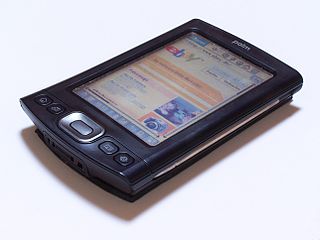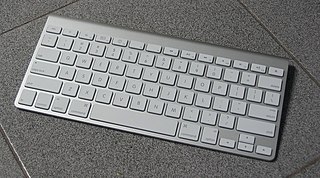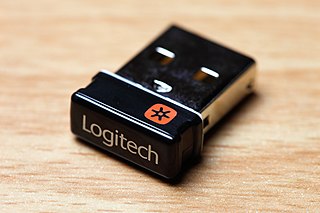
A computer mouse is a hand-held pointing device that detects two-dimensional motion relative to a surface. This motion is typically translated into the motion of the pointer on a display, which allows a smooth control of the graphical user interface of a computer.

A personal digital assistant (PDA) is a multi-purpose mobile device which functions as a personal information manager. Following a boom in the 1990s and 2000s, PDA's were mostly displaced by the widespread adoption of more highly capable smartphones, in particular those based on iOS and Android in the late 2000s, and thus saw a rapid decline.

An optical mouse is a computer mouse which uses a light source, typically a light-emitting diode (LED), and a light detector, such as an array of photodiodes, to detect movement relative to a surface. Variations of the optical mouse have largely replaced the older mechanical mouse design, which uses moving parts to sense motion.
Microsoft has designed and sold a variety of ergonomic keyboards for computers. The oldest is the Microsoft Natural Keyboard, released in 1994, the company's first computer keyboard. The newest models are the Sculpt Ergonomic Keyboard (2013), the Surface Ergonomic Keyboard (2016), and the Microsoft Ergonomic Keyboard (2019).
A human interface device (HID) is a type of computer device usually used by humans that takes input from or provides output to humans.

The Apple Mouse (A1152) is a multi-control USB mouse manufactured by Mitsumi Electric and sold by Apple Inc. It was announced and sold for the first time on August 2, 2005, and a Bluetooth version was available from 2006 to 2009. Before the Mighty Mouse, Apple had sold only one-button mice with its computers, beginning with the Apple Lisa 22 years earlier. The Mighty Mouse supported two buttons, and a miniature trackball for scrolling.

The Apple Wireless Keyboard is a wireless keyboard built for Macintosh computers and compatible with iOS devices. It interacts over Bluetooth wireless technology and unlike its wired version, it has no USB connectors or ports. Both generations have low-power features when not in use. It was discontinued on October 13, 2015, and was succeeded by the new Magic Keyboard.
Microsoft IntelliPoint is the Microsoft-branded software driver for the company's hardware mice. Microsoft has released versions for both Windows and Mac OS X. It has been succeeded by Microsoft Mouse and Keyboard Center, which combines IntelliType with IntelliPoint.
In computing, the USB human interface device class is a part of the USB specification for computer peripherals: it specifies a device class for human interface devices such as keyboards, mice, touchscreen, game controllers and alphanumeric display devices.

Microsoft IntelliType is the brand driver for Microsoft's series of computer keyboards. Microsoft releases versions for both Windows and Mac OS X. It has been succeeded by Microsoft Mouse and Keyboard Center, which combines IntelliType with IntelliPoint.

IntelliMouse is a series of computer mice from Microsoft. The IntelliMouse series is credited with a number of innovations; Microsoft was among the first mouse vendors to introduce a scroll wheel, an optical mouse, and dedicated auxiliary buttons on the side of the mouse. They use IntelliPoint drivers and its main competitor through the years has been Logitech.

Apple Inc. has designed and manufactured several models of mice, trackpads, and other pointing devices, primarily for use with Macintosh computers. Over the years, Apple has maintained a distinct form and function with its mice that reflect their design languages of that time. Apple's current external pointing devices are the Magic Mouse 2 and Magic Trackpad 2.
HIDPoint is proprietary Linux software for USB Keyboards and Mice. Currently it supports most Logitech keyboards and mice. It runs on many Linux distributions such as RHEL, SUSE, Ubuntu and Fedora. HIDPoint has been designed to give users using USB Mice and Keyboards the same experience they get when using these devices on Microsoft Windows.
Some of the new features included in Windows 7 are advancements in touch, speech and handwriting recognition, support for virtual hard disks, support for additional file formats, improved performance on multi-core processors, improved boot performance, and kernel improvements.

In computing, an input device is a piece of equipment used to provide data and control signals to an information processing system, such as a computer or information appliance. Examples of input devices include keyboards, computer mice, scanners, cameras, joysticks, and microphones.

The Logitech Unifying Receiver is a small dedicated USB wireless receiver, based on the nRF24L-family of RF devices, that allows up to six compatible Logitech human interface devices to be linked to the same computer using 2.4 GHz band radio communication. Receivers that are bundled with a Logitech product are paired with the device at the factory. When purchasing a replacement receiver or connecting multiple devices to one receiver, pairing requires the free-of-charge Logitech Unifying software, available for Microsoft Windows and macOS. On Linux, the Solaar software can be used to adjust the configurations. Although not compatible with Bluetooth, devices pair to Unifying Receivers in a similar way. Peripherals remain paired, and can then be used on systems not supporting the software. Logitech receivers compatible with the Unifying protocol can be identified by the orange Unifying logo, which distinguishes them from Logitech Nano receivers of similar appearance, which pair similarly but only with a single device, without using the Unifying protocol.

The Samsung Galaxy TabPro S is a 12-inch Windows 10-based 2-in-1 PC produced and marketed by Samsung Electronics. It came in a standard version and a Gold version. The TabPro S marked the first device in the Samsung Galaxy series to run Microsoft Windows, making it a departure from the traditionally Android-powered Galaxy lineup and marked the end of the Samsung Ativ brand. Unveiled at Consumer Electronics Show 2016, alongside Samsung Notebook 9, the TabPro S was released on March 18, 2016.

The power key, or power button, is a key found on many computer keyboards during the 1980s and into the early 2000s. They were introduced on the first Apple Desktop Bus keyboards in the 1980s and have been a standard feature of many Macintosh keyboards since then. They are also found on an increasing number of Microsoft Windows keyboards, sometimes supplanted with additional keys for sleep. The power key is becoming increasingly rare.











